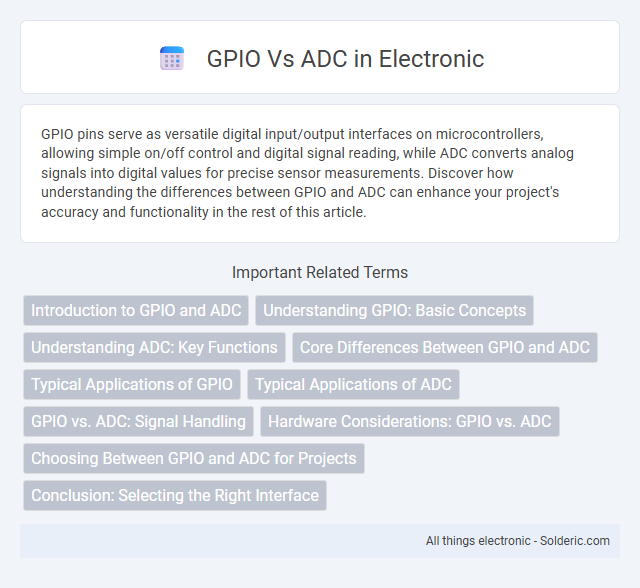GPIO pins serve as versatile digital input/output interfaces on microcontrollers, allowing simple on/off control and digital signal reading, while ADC converts analog signals into digital values for precise sensor measurements. Discover how understanding the differences between GPIO and ADC can enhance your project's accuracy and functionality in the rest of this article.
Comparison Table
| Feature | GPIO (General Purpose Input/Output) | ADC (Analog-to-Digital Converter) |
|---|---|---|
| Function | Digital input or output pins | Converts analog signals to digital values |
| Signal Type | Digital (0 or 1) | Analog (continuous voltage levels) |
| Use Case | Switches, LEDs, digital sensors | Temperature sensors, potentiometers, audio signals |
| Resolution | 1 bit per pin | Typically 8, 10, 12, or higher bits |
| Data Type | Binary (HIGH/LOW) | Multi-bit digital number |
| Complexity | Simple input/output control | Requires sampling and conversion logic |
| Example Devices | Microcontroller digital pins | Microcontroller ADC modules, standalone ADC ICs |
Introduction to GPIO and ADC
GPIO (General-Purpose Input/Output) pins serve as versatile digital interfaces on microcontrollers, enabling direct control and reading of binary signals such as switches, LEDs, and digital sensors. ADC (Analog-to-Digital Converter) modules transform continuous analog signals, like temperature or light intensity, into discrete digital values for microcontroller processing. Both GPIO and ADC are fundamental for interfacing with external components but handle different signal types essential for embedded system design.
Understanding GPIO: Basic Concepts
GPIO (General-Purpose Input/Output) pins serve as versatile digital interfaces on microcontrollers, capable of reading or writing binary values (HIGH or LOW) to interact with sensors, switches, and LEDs. Unlike ADC (Analog-to-Digital Converter) pins, which interpret varying voltage levels into digital values, GPIO pins strictly handle digital signals without measuring voltage magnitude. Understanding GPIO's basic operations, including setting pin direction and reading or writing digital states, is essential for controlling and monitoring digital devices in embedded systems.
Understanding ADC: Key Functions
ADC (Analog-to-Digital Converter) transforms analog signals from sensors into digital data that microcontrollers can process, enabling precise measurement of voltage levels. Unlike GPIO pins that handle simple digital inputs and outputs, your ADC captures continuous signals with high resolution, essential for monitoring temperature, light, or sound intensity. Key ADC functions include sampling rates, resolution (bit depth), and reference voltage, which directly impact the accuracy and reliability of analog signal conversion.
Core Differences Between GPIO and ADC
GPIO (General Purpose Input/Output) pins serve as basic digital interfaces on microcontrollers, allowing for simple binary input or output operations such as reading button presses or driving LEDs. ADC (Analog-to-Digital Converter) pins, in contrast, enable the microcontroller to read varying analog voltage levels by converting these signals into digital values, essential for sensors like temperature or light sensors. The core difference lies in their function: GPIO handles digital signals as either high or low states, while ADC processes continuous analog signals for precise measurement and analysis.
Typical Applications of GPIO
GPIO (General Purpose Input/Output) pins are commonly used in applications such as controlling LEDs, reading button states, and interfacing with digital sensors or switches. These pins enable your microcontroller to send or receive binary signals, making them essential for tasks that require simple on/off or toggle control. Typical uses of GPIO include driving relays, detecting motion with digital PIR sensors, and communicating with modules like keypads or LCD displays.
Typical Applications of ADC
ADC (Analog-to-Digital Converter) is crucial for converting analog signals from sensors, such as temperature, pressure, and light sensors, into digital data for microcontrollers. Typical applications of ADC include data acquisition systems, audio signal processing, and industrial automation, where precise measurement and digital interpretation of analog inputs are essential. Your projects benefit from ADC when accurate sensor readings are necessary for control and monitoring functions.
GPIO vs. ADC: Signal Handling
GPIO pins handle digital signals by detecting or outputting distinct high or low voltage levels, making them ideal for simple on/off or binary input tasks. ADC pins convert analog voltage signals into digital values, enabling precise measurement of variable signals such as temperature, light intensity, or sound levels. Your choice depends on whether you need to interpret binary digital states or analyze continuous analog inputs for accurate signal processing.
Hardware Considerations: GPIO vs. ADC
GPIO pins function as digital input/output interfaces allowing simple high or low voltage signals, while ADC channels convert analog signals into digital values for precise measurement. Hardware considerations include GPIO's straightforward circuitry and lower power consumption versus ADC's need for precise voltage reference, sampling rate, and signal conditioning components. Selecting between GPIO and ADC depends on application requirements such as digital logic control versus analog signal processing and resolution accuracy.
Choosing Between GPIO and ADC for Projects
Choosing between GPIO and ADC depends on the type of input signal in your project: GPIO pins are suitable for digital signals with two states (HIGH or LOW), while ADC pins are essential for reading analog signals that vary continuously. Projects requiring precise measurement of sensor values such as temperature, light, or sound intensity benefit from ADC to convert analog data into digital form. For simple on/off controls, switches, or binary sensors, GPIO pins offer direct, cost-effective interfacing options.
Conclusion: Selecting the Right Interface
Selecting the right interface between GPIO and ADC depends on the application requirements, with GPIO providing simple digital input/output control, while ADC offers precise analog signal conversion for sensor data. GPIO suits tasks like toggling switches or reading digital sensors, whereas ADC is essential for monitoring varying voltage levels in analog devices. Understanding the nature of the signal and precision needed ensures optimal performance and system efficiency.
GPIO vs ADC Infographic

 solderic.com
solderic.com